My Writings (I hope!) reflect my Guiding Principles: -'Enjoy Life to the Utmost but not at other people's expense'-'Think Global, Act Local'-'Variety is the Spice of Life'-'Use Technology & Wisdom to Make the World A Better Place for All God's Creatures'-'Do Not Accept Injustice No Matter Where You Find It'-'Laughter is the Best Medicine'
1980s Reports on Westminster Paedophile ring missing. Surprised?
Thatcher: A Destroyer of Communities
When she became Prime Minister in 1978, she used the words of St. Francis to define the tenets of her new government, “Where there is discord, may we bring harmony. Where there is error, may we bring truth. Where there is doubt, may we bring faith. And where there is despair, may we bring hope."
 |
| Thatcher with Pinochet |
US President Ronald Reagan and Thatcher were united in building a new expensive generation of nuclear missiles (Cruise & Pershings) that were to be placed on British and European soil. This decision spawned an international peace movement that included the huge female peace camp outside the RAF base at Greenham Common Berkshire where these weapons were to be sited.
Thatcher used all the forces of the state to destroy traditional mining communities in England.
The Poll Tax left to high levels of civil unrest.
She left Britain a deeply divided unequal society.
 |
| Thatcher with Rupert Murdoch |
Hugo Chavez: Hero of the Revolution
 |
| Viva Chavez! La Lucha Continúa! |
Hugo Chavez's legacy of fighting against injustice, poverty and oppression will live on in Venezuela and across the world.
As former US President Jimmy Carter stated, "We came to know a man who expressed a vision to bring profound changes to his country to benefit especially those people who had felt neglected and marginalized. Although we have not agreed with all of the methods followed by his government, we have never doubted Hugo Chávez’s commitment to improving the lives of millions of his fellow countrymen... President Chávez will be remembered for his bold assertion of autonomy and independence for Latin American governments and for his formidable communication skills and personal connection with supporters in his country and abroad to whom he gave hope and empowerment. During his 14-year tenure, Chávez joined other leaders in Latin America and the Caribbean to create new forms of integration. Venezuelan poverty rates were cut in half, and millions received identification documents for the first time allowing them to participate more effectively in their country’s economic and political life."
Hugo followed in the footsteps of other great heroic Latino revolutionaries such as Simon Bolivar, Augusto Sandino, Che Guevera, Salvador Allende and Daniel Ortega who fought to free their people from colonialism, neo-colonialism, elitism, brutality & poverty.
Chavez has and will continue to be an iconic role model across the continent. His success in standing up to the oil oligarchs, their right-wing political lackeys in the USA and compliant indigenous corrupt wealthy governing elites, inspired progressive democrats in many South American countries to organise and win elections in Bolivia, Peru, Paraguay, Ecuador and elsewhere,
As an Irishman, I see in Chavez and other South American revolutionaries the courageous visionary patriotic spirit that imbued so many Irish rebels from Wolfe Tone and Robert Emmet through to Pearse and Connolly in their struggles to free our people from brutal foreign occupation.
Castle Ellen: Birthplace of Edward Carson's mother
Recently I had the honour to lead a group of heritage enthusiasts to visit the historical Georgian mansion of Castle Ellen (Caisleán Eilise). former home of the Anglo-Irish Lambert family.
Our guide through its fascinating halls, out-buildings and grounds was its owner Miceál Keaney.
It was interesting to learn from Miceál that arch Unionist and the great hate figure of Irish republicanism, Edward Carson, spent many happy times at Castle Ellen, which was the birthplace of his mother Isabella. Edward was also the barrister responsible for prosecuting and ending the career of Oscar Wilde, his former friend.
Miceál bought the demesne in 1974 when it was the buildings were in an advance state of disrepair and has spent much energies and monies over the subsequent years endeavouring to bring the place back to its former Victorian aristocratic splendour. A true labour of love that he deserves great admiration for.
In the process, he has built up an eclectic mix of memorabilia, from military artifacts to ancient farmyard machinery. You can almost feel the ghosts of the British Empire drift as you wander through the remnants of croquet and tennis lawns, a series of walled gardens with orchards and maze, a tree lined avenue, a pony-driven water well and an underground livestock tunnel.
Well worth a visit.
Contact info@castleellen.com
Bloody Sunday: Truth & Justice at Last!

June 2010 was an historical month for Ireland & Britain. Truth and Justice finally won out over decades of state propaganda and blatant lies as a British government finally admitted that the 14 people killed in Derry by the British Army on Bloody Sunday 1972 were unarmed innocent civilians taking part in a Civil Rights march.
The Saville Report stated that the soldiers called before it had lied; that none of those killed were carrying weapons, that no warnings were given, that no soldiers were under threat at the time and that the soldiers were the first to open fire.
These findings totally contradict the statements of the British army and officialdom from the time of the killings onwards. Particularly scurrilous were the findings of the Widgery report published in April 1972 which was recognised at the time by independent minds as nothing more than a whitewash. For in spite of evidence to the contrary, Lord Widgery concluded that the soldiers were fired on first and blamed the marchers for participating in an illegal march (which was part of ongoing peaceful protests calling for an end to discrimination against Catholics in Unionist Protestant statelet of Northern Ireland).
Northern Ireland during the 'Troubles' (1969-1990s) was used by the British Army and the British secret services as a real laboratory for testing out methods, tactics and weapons that could be used someday to combat expected social unrest in Britain (and were to a degree used in mid-1980s in areas of British inner cities such as Brixton & Toxeth). Internment and non-jury courts were introduced. A series of miscarriages of justice took place where innocent Irish people were jailed for crimes that they did not commit. The most notable were the Guildford Ford and the Birmingham Six jailed in the 1970s and finally exonerated and released in 1991. (I played a humble and small part in this campaign, being chairperson in the laste 1980s of the West of Ireland 'Release the Birmingham 6 & Guildford 4' committee)
British forces, their agents and their loyalist allies also undertook a series of covert operations both in Northern Ireland and the Irish republic that included bank raids, shootings, secret assassinations, bombing, many of which were deliberately blamed on the IRA in an effort to discredit Irish civil rights activists and republicans. Some day the truth of the British establishment's secret and dirty war in Northern Ireland will be made known and published.
But in the meantime- Fair play to Prime Minister David Cameron for being the first British leader to apologise unequivocally over military crimes against civilians. Truly historical.
Northern Ireland’s Sperrin Mountains–a hidden Rural Gaelic heartland
I have just spent a few wonderful days living in the midst of the Sperrin Mountains, a region of untold natural beauty and a stronghold of vibrant Gaelic culture.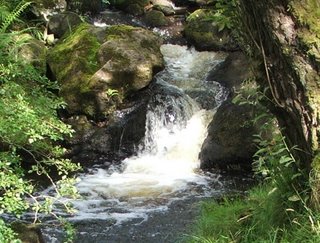 I was pleasantly surprised to come across such a vast area of largely unspoilt natural beauty in development-driven Ireland. Unlike most of the rural regions of the Irish republic that are sadly being urbanised at an alarming rate, there are here stringent controls on building and road construction, on overgrazing as well as the ample provision of state funds to protect natural heritage.
I was pleasantly surprised to come across such a vast area of largely unspoilt natural beauty in development-driven Ireland. Unlike most of the rural regions of the Irish republic that are sadly being urbanised at an alarming rate, there are here stringent controls on building and road construction, on overgrazing as well as the ample provision of state funds to protect natural heritage.
Our northern brethren & the British government can teach us southerners a thing or two on environment protection and land management.
The Sperrin region consists of a landscape of gently rolling mountains, deep valleys (glens), small streams and boglands where ‘sheep’ is king.
 Here farming seems to be thriving: you can see young farmers driving tractors, sheep pens dotting the hillsides and busy market days in towns such as Draperstown.
Here farming seems to be thriving: you can see young farmers driving tractors, sheep pens dotting the hillsides and busy market days in towns such as Draperstown.  Sizeable government grants are provided to stop sheep grazing mountains at certain times of the year so flora can blossom and provide cover for nesting birds.
Sizeable government grants are provided to stop sheep grazing mountains at certain times of the year so flora can blossom and provide cover for nesting birds.
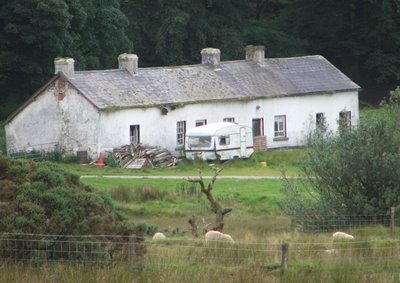 This farm building is home to the 'sheep collector', a man whose job is collect stray sheep and return them to their owner. The animals are identified by the colour and shape of the dye on their wool.
This farm building is home to the 'sheep collector', a man whose job is collect stray sheep and return them to their owner. The animals are identified by the colour and shape of the dye on their wool. The Flaming Red of the Rowan Tree
The Flaming Red of the Rowan Tree
At this time of year in the Sperrins, one of the great Irish trees of Celtic mythology- the 'Mountain Ash'- gives a beautiful red colour to the autumn days. Also known as the 'Rowan', or 'Caorthann' in Irish, the red berry fruit of this tree only matures in the autumn thereby providing much needed food to wildlife. Its redness and bearer of autumn food made it associated in ancient Celtic times with life giving properties and with fire.
Amazingly for the 21st century, you come across more cyclists, walkers and farm vehicles than cars along the narrow roadways.
A large re-forestation programme is underway. Though primarily commercial and dominated by conifers, nevertheless it is helping to re-introduce the forests that once dominated the landscape. Interestingly, copses of trees woods sprinkle the hillsides planted by farmers to provide shelter for their sheep
The Sperrins are reminiscent of an Ireland that existed 150 years ago.
 Mountain Stream
Mountain Stream The intricate detail shown in the stone walls of this old farm building is testimony to the superb
The intricate detail shown in the stone walls of this old farm building is testimony to the superbcraftmanship of the buliders of a bygone era
The area is also steeped in pre-history: it is a treasure trove of stone circles and megalith tombs some dating back 5,000 years.
Catholic Highlands & Protestant Lowlands But it is its living folk traditions that helps bolster the unique identity that is the Sperrins. Traditional Gaelic music thrives in the pubs and schools; the names of most mountains, rivers, woods and towns are Gaelic in origins and labelled on all road signs. Monuments and posters to IRA volunteers and hunger strikers give visual expression to the strong republicanism that permeates many of the local population, the majority of whom are Catholic. Television news bulletins over the last few decades often spoke of finds of secret weaponry caches in the Sperrins. The inaccessible terrain with its dozens of abandoned farmsteads must have provided safe hide-outs for many an armed republican. Interestingly, locals also speak of other visitors staying incognito in these old buildings, namely British army undercover squads their presence often identified by the butts of their cigarettes left behind.
But it is its living folk traditions that helps bolster the unique identity that is the Sperrins. Traditional Gaelic music thrives in the pubs and schools; the names of most mountains, rivers, woods and towns are Gaelic in origins and labelled on all road signs. Monuments and posters to IRA volunteers and hunger strikers give visual expression to the strong republicanism that permeates many of the local population, the majority of whom are Catholic. Television news bulletins over the last few decades often spoke of finds of secret weaponry caches in the Sperrins. The inaccessible terrain with its dozens of abandoned farmsteads must have provided safe hide-outs for many an armed republican. Interestingly, locals also speak of other visitors staying incognito in these old buildings, namely British army undercover squads their presence often identified by the butts of their cigarettes left behind. A Roadside Poster Sign dedicated to the IRA prisoners who died on hunger strike in British jails in their efforts to have the British authorities accord them 'political' rather than 'criminal' status
A Roadside Poster Sign dedicated to the IRA prisoners who died on hunger strike in British jails in their efforts to have the British authorities accord them 'political' rather than 'criminal' status
 An old abandoned farm house. Notice its three-levelled structure which I believe was divided as follows: the larger section was for human habitation, the middle section for storage of grain and somtimes larger animals and the smallest section for poultry or pigs
An old abandoned farm house. Notice its three-levelled structure which I believe was divided as follows: the larger section was for human habitation, the middle section for storage of grain and somtimes larger animals and the smallest section for poultry or pigsIt was a lean and hungry life in the Sperrins; the dozens of ruined homesteads bear grim testimony to the harshness of their new existence which eventually forced many to emigrate.
‘Raparrees’: Ireland’s ‘Robin Hoods’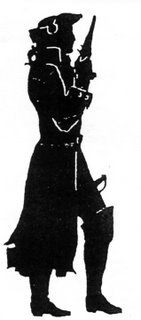 But the natives did not accept the loss of their lands lightly. From the forests of the Sperrins, armed raids were launched on the settlers in the lowlands during the seventeenth, eighteenth and early nineteenth centuries. Many of these rebels became famed in song and verse for taking on the British occupiers, robbing wealthy colonists and giving the money to starving and destitute people many of whom were now reduced to the status of tenants on their former lands. These armed horsemen were known as ‘Tories’ but more usually as 'Rapparees' and were looked as by the local populace as the Irish equivalent of the English ‘Robin Hoods’. The term ‘Rapparees’ probably derives from a mix of Irish (ri= king) and French (rapier=sword) words that translates as the ‘King’s Swordsmen,’. For many of these highwaymen were originally Gaelic Catholic gentry who had joined the army of the Catholic British King James 1 in the hope of reclaiming their lost lands.
But the natives did not accept the loss of their lands lightly. From the forests of the Sperrins, armed raids were launched on the settlers in the lowlands during the seventeenth, eighteenth and early nineteenth centuries. Many of these rebels became famed in song and verse for taking on the British occupiers, robbing wealthy colonists and giving the money to starving and destitute people many of whom were now reduced to the status of tenants on their former lands. These armed horsemen were known as ‘Tories’ but more usually as 'Rapparees' and were looked as by the local populace as the Irish equivalent of the English ‘Robin Hoods’. The term ‘Rapparees’ probably derives from a mix of Irish (ri= king) and French (rapier=sword) words that translates as the ‘King’s Swordsmen,’. For many of these highwaymen were originally Gaelic Catholic gentry who had joined the army of the Catholic British King James 1 in the hope of reclaiming their lost lands.
Probably the most famous Sperrin outlaw was Shane Crossagh who operated in the late 17th and early 18th centuries. According to Jim McCallen in his book ‘Stand & Deliver’, Shane’s real surname was “McMullan’; Crossagh meaning ‘pock-marked’ was a nickname. He took to the hills after he narrowly evaded capture during a secret visit to his family’s former home from whence they had been evicted. There are many tales of his gang’s daring exploits. One relates to a British General Napier who was overheard by Shane boasting in an inn one night that he would have the rebel’s head on a pike within the week. Next morning the general and his cavalry unit were ambushed by Shane’s men at a bridge near the village of Feeny. After the soldiers were forced to surrender, they were stripped, tied up in pairs and marched off led by General Napier dressed up as a women!
Brave Death of a Raparree
But Shane was eventually caught and sentenced to be hanged along with his two sons. However, he was surprisingly offered pardon by an influential planter Henry Carey, whose life he had once saved. But when he was told that his sons were not to be spared, he declined the offer of a pardon. According to a witness- John Low the Presbyterian minister of Banagher- he died with a son either side of him, holding each by the hand after making a speech to an sympathetic crowd thanking them for their support over his years as an outlaw.
 The place of Presbyterian worship in the centre of Draperstown. Not as ornate as a Catholic or Anglican church, nevertheless it possesses an innate beauty of its own.
The place of Presbyterian worship in the centre of Draperstown. Not as ornate as a Catholic or Anglican church, nevertheless it possesses an innate beauty of its own.'The Wind that Shakes the Barley'... A 'Must See' Film for Irish and British people

What a film! One of the best and most evocative films that I have ever seen.
The storyline, the production and the acting were first class. The motley group of Iraqi, American and Irish friends that went with me to the movie were emotionally captived by the performances. Huda and my wife Cepta were reduced to tears; my 'green' Irish rebel heart was beating with joy one minute, with anger and sorrow the next. I could see images of my own grandparents and grandcousins in so many of the onscreen roles.
In its portrayal of the 'Irish War on Independence', the 'Wind that Shakes the Barley' brilliantly touched on universal themes that could be placed in any age, in any country across the world that is or was experiencing occupation by a foreign military force. It particularly captured the essential racism and terrorism of all armies of occuption as they try and fight a native guerilla force that is deeply woven into the fabric of a local community. In the film, the British forces carry out classic counter-insurgancy tactics that almost always fail in the end. In response to the successful guerilla campign of the IRA, the British government created what John Walsh of the English 'Independent' newspaper recently called modern Europe's first state-sanctioned terror group. The orders for this army force (the 'Black and Tans')-comprising many criminals and recently released prisoners-was to initiate a reign of pure terror against the civilian population and bludgeon them into submitting to British rule.
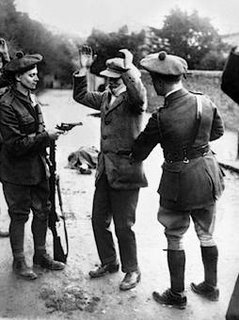
In the film as in real life, they left a trail of death and destruction in their wake- burning streets and houses, shooting innocent civilians, torturing prisoners and carrying out summary executions. Their open racist contempt for the natives was shown in the film not just in their brutality but in their verbal abuse and sneering of the Irish and all things Irish. Their words and actions reminded so much of Israelis' comments this week towards the Lebanese; of American GI language towards the Iraqis and formerly the Vietnamese; of the Turks towards the Kurds; of Bosnian Serbs towards the Muslims; of Russians towards the Chechens; pf Sudanese Arabs towards the Darfur negroes... Yet the British atrocities only had the opposite effect to what the their government had hoped for, with support and recruitment to the Irish republican resistence only increasing.
But the movie also admirably showed the underlying tensions and divisions that existed in the Irish republican movement. The scenes that centred on the debates and arguments over the terms of the Treaty brought back by Michael Collins from London were classic! One of my favourite moments though was when a Irish republican court -operated by an almost exclusive all-female (!) judiciary- awarded in favour of a poor woman who was unable to pay the principle and exhorbant interest for a loan that she had obtained from a wealthy Irish businessman. Priceless! But the next scene then showed an IRA unit going in and forcibly releasing the convicted businessman. Why? Because they needed his money to buy rifles and bullets to fight the British! For already the seeds for the divisions and largely social class conflict of the Irish civil war of 1922 were been sown.
The movie also cast light on many other forgotten aspects of this period of Irish history:
-the prominent role of women in the resistance movement
-the refusal of the Irish railway workers to transport British military personnel and weaponry
-the execution of 'traitors' by the IRA volunteers of men they once called friends
-the excommunication by the Catholic Church bishops of anti-treaty republicans
-the racist attitudes of the landed aristocracy towards the native Irish
-the network of farm houses that provided food and lodgings to the IRA
-the excellent guerilla tactics employed by the IRA
-the high level of IRA weaponry that came from raids on British police barracks
The British 'Independent' reporter John Walsh said of the film, "At last a film that brings the truth to British eyes (of British rule in Ireland)". The same could also be said of Irish eyes. Ken Loach has done a great service to both countries
Film on Ireland's 'War of Independence': Obvious comparisons to modern Iraq
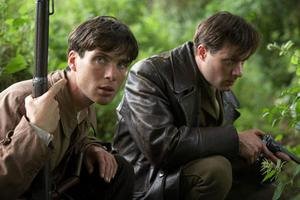 Well done to the British film producer, Ken Loach. His film - 'The Wind that Shakes the Barley' - on the subject of the 'Irish War of Independence' has being condemned viciously by the British tabloid press. Which must be a good thing!
Well done to the British film producer, Ken Loach. His film - 'The Wind that Shakes the Barley' - on the subject of the 'Irish War of Independence' has being condemned viciously by the British tabloid press. Which must be a good thing!'The Sun' and other similar newspapers tore him asunder for exposing the terror tactics of the British army against the Irish population during the War of Independence (1918-1921). But he told nothing but the truth about the British paramilitary units known as the 'Black 'n' Tans' (so called becasue they wore a mix of brown and black uniforms) who committed so many atrocities against civilians- torture, burnings, drunken rampages, murders.... that, as with Cromwell's armies of the mid-17th century, they will live forever as demons in the folklore of Ireland. But for the British establishment today it is embarrassing that people will make the obvious comparision to the tactics of the US & UK occupation military forces in present day Iraq.
Ken is representative of an honourary tradition amongst a section of British society who always had the courage to speak the truth about Ireland and other issues of worldwide human rights and suffered much personal abuse and vilification as a result. People such as Gareth Pierce, Tony Benn, Ken Livingstone and Chris Mullins spring to mind.
Irish, Iraqis and Americans 'out on the town' together!
I am going to see the film tomorrow night in the company of my wife Cepta and some friends who happen to be Iraqis and American anti-war activists. They requested me to go with them because of my political views as well as my family's involvement as IRA volunteers in this war of liberation of 1918-'21. But my family were typical of this period-so I hold no special knowledge except that I listened too many a fireside chat when I was a little boy as these old veterans told their stories.
Anyway, our pub conversation after the movie should be priceless!
So I will give you my views on the movie in my next posting










